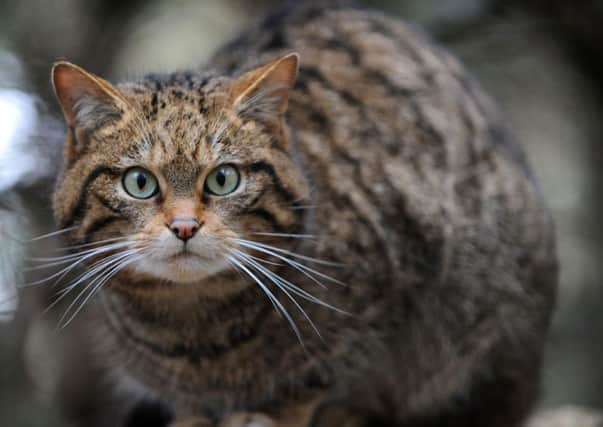Scottish wildcat sanctuary to double in size


A location on the remote Ardnamurchan peninsula was designated a protected area for the endangered cat - nicknamed the Highland Tiger - last year.
It is being extended to taken in parts of Morvern to now give the haven a total coverage of 500 square miles.
Advertisement
Hide AdAdvertisement
Hide AdWildcat Haven in Ardnamurchan and Sunart was established in 2008 by the Scottish Wildcat Association with US grant funding but is now a standalone project made up of a team of ecologists, wildlife experts, vets, teachers and landowners.
Domestic cats in and around the wildcat green zone are being neutered to prevent them breeding with pure wildcats.
Mixing with domestic cats, disease and loss of habitat have led to wildcats becoming an endangered species.
Last year there were warnings that numbers of pure-bred wildcats may have fallen to about 35 individuals - less than a tenth of previous estimates - and 70 times rarer than the giant panda.
A team put together by the Scottish Wildcat Association reviewed 2,000 records of camera trap sightings, eyewitness reports and also road kills.
Other research has estimated that there could be less than 400 pure-bred cats.
And a report on a project funded by Scottish Natural Heritage has calculated that there were 150 breeding pairs left.
Under the new initiative, by 2019 the partnership project aims to have identified and secured at least five stable populations of Scottish wildcats in the wild.
Advertisement
Hide AdAdvertisement
Hide AdIt also aims to promote in these areas greater awareness of the threats to wildcats from feral cats, domestic cats and hybrids; ensured that householders and others in wildcat ‘hot spots’ recognise the importance of having their cats neutered and vaccinated and have a better understanding of wildcat distribution, numbers and the extent of hybridisation with domestic cats.
FOLLOW US
SCOTSMAN TABLET AND MOBILE APPS
The Morvern project involves scientist Dr Paul O’Donoghue and Kent-based charity the Aspinall Foundation.
They believe wildcats’ best chance of surviving is in the remotest parts of Scotland.
Ardnamurchan and Morvern include some of Scotland’s wildest landscapes and few human residents.
The main communities in Ardnamurchan - Acharacle and Strontian - have populations of about 560 and 350.
The haven project is separate from one involving six priority areas for Scottish wildcat conservation identified following research commissioned by SNH.
Thee Angus Glens, Strathbogie in Aberdeenshire, Strathavon in Moray and Morvern, Strathpeffer and Dulnain in the Highlands are the six areas.
The research suggested these were where wildcats had the best chance.
Advertisement
Hide AdAdvertisement
Hide AdNine areas were assessed as part of the multi-agency Wildcat Action project.
Last year, after five years of neutering and vaccinating feral and pet cats, Wildcat Haven established a 250 sq mile area on the Ardnamurchan peninsula that was free from feral cats and feline diseases.
Called Wildcat Haven, this is now the only place in Scotland where the Scottish wildcat can breed without the risk of hybridisation.
Field work began this week with teams of vets and biologists.
Emily O’Donoghue, director of the Wildcat Haven project, said the backing of the local community is essential.
She said: “The support from the local communities has been fantastic and central to our work.
“We are fortunate to work with a diverse range of stakeholders, from landowners to the local schools and without them we could not save the wildcat.”
Nick Morphet, head vet for the Wildcat Haven, said: “We are very excited about the current fieldwork season and we are putting out an appeal to all the residents on the Ardnamurchan and Morvern peninsulas.
Advertisement
Hide AdAdvertisement
Hide Ad“If they have any wildcats or feral cats that visit their gardens or have a pet cat that they want neutering or micro-chipping free of charge, then we would love to hear from them.”
Henry Dobson, conservation officer for Forestry Commission Scotland, said it is committed to helping halt the decline of the Scottish wildcat and recognises the importance of Morvern for the endangered animal.
“Wildcats range over large areas and face a number of threats so we realise the importance of working with different groups to give the wildcat the best chance of recovery,” he said.
SEE ALSO